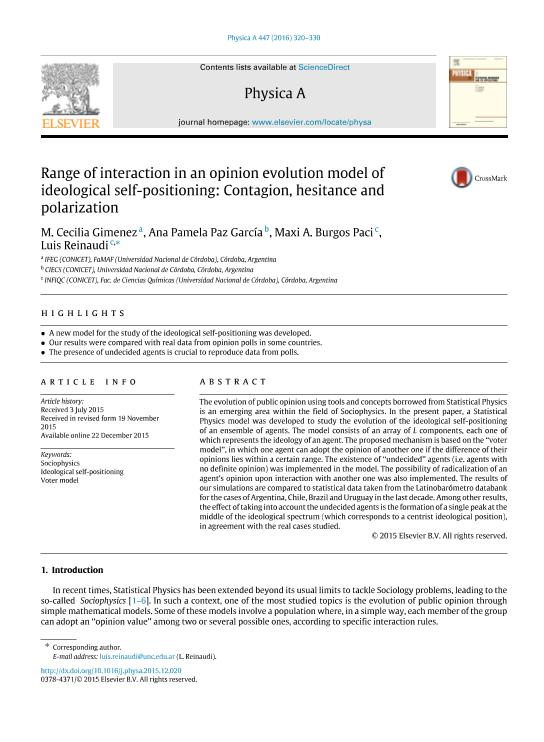Artículo
Range of interaction in an opinion evolution model of ideological self-positioning: Contagion, hesitance and polarization
Fecha de publicación:
04/2016
Editorial:
Elsevier Science
Revista:
Physica A: Statistical Mechanics and its Applications
ISSN:
0378-4371
Idioma:
Inglés
Tipo de recurso:
Artículo publicado
Clasificación temática:
Resumen
The evolution of public opinion using tools and concepts borrowed from Statistical Physics is an emerging area within the field of Sociophysics. In the present paper, a Statistical Physics model was developed to study the evolution of the ideological self-positioning of an ensemble of agents. The model consists of an array of L components, each one of which represents the ideology of an agent. The proposed mechanism is based on the "voter model", in which one agent can adopt the opinion of another one if the difference of their opinions lies within a certain range. The existence of "undecided" agents (i.e. agents with no definite opinion) was implemented in the model. The possibility of radicalization of an agent's opinion upon interaction with another one was also implemented. The results of our simulations are compared to statistical data taken from the Latinobarómetro databank for the cases of Argentina, Chile, Brazil and Uruguay in the last decade. Among other results, the effect of taking into account the undecided agents is the formation of a single peak at the middle of the ideological spectrum (which corresponds to a centrist ideological position), in agreement with the real cases studied.
Palabras clave:
Ideological Self-Positioning
,
Sociophysics
,
Voter Model
Archivos asociados
Licencia
Identificadores
Colecciones
Articulos(CIECS)
Articulos de CENTRO DE INVESTIGACIONES Y ESTUDIO SOBRE CULTURA Y SOCIEDAD
Articulos de CENTRO DE INVESTIGACIONES Y ESTUDIO SOBRE CULTURA Y SOCIEDAD
Citación
Gimenez, Maria Cecilia; Paz Garcia, Ana Pamela; Burgos Paci, Maximiliano Alberto; Reinaudi, Luis; Range of interaction in an opinion evolution model of ideological self-positioning: Contagion, hesitance and polarization; Elsevier Science; Physica A: Statistical Mechanics and its Applications; 447; 4-2016; 320-330
Compartir
Altmétricas




